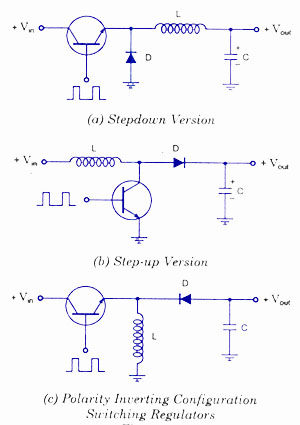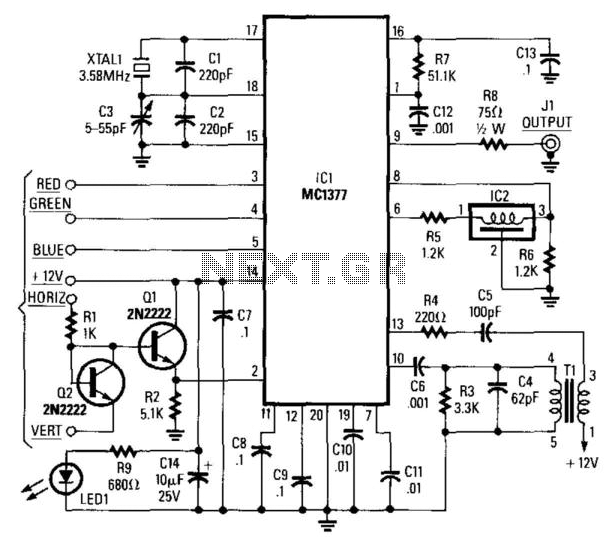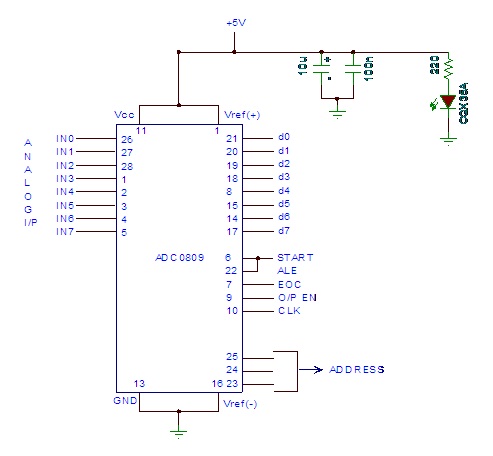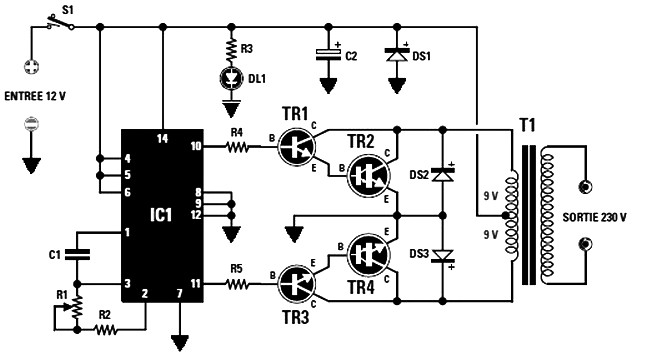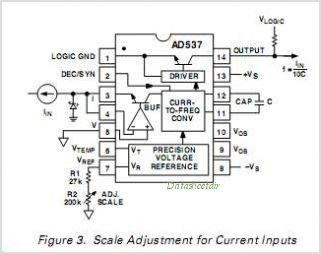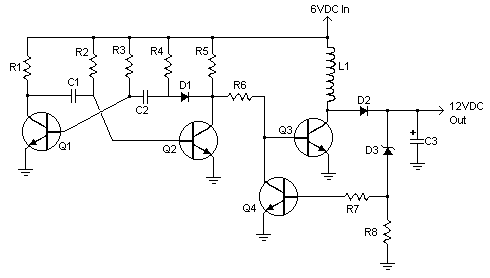
Analogs ADP1821 Step Down DC-to-DC Converter
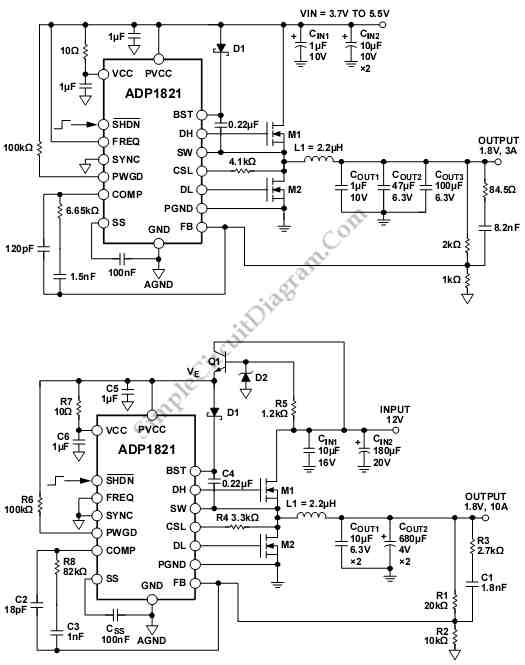
The schematic diagram below illustrates an ADP1821 Step Down DC-to-DC Converter circuit. This circuit employs the ADP1821, which is capable of regulating an output with a load exceeding 20 A, contingent upon the careful selection of power components such as MOSFETs, bulk capacitors, and inductors to meet the power requirements. The power train components limit power dissipation and the maximum load. To achieve the 20 A load, two low-side MOSFETs are necessary. The first circuit serves as a typical application circuit capable of driving a 3 A load using an all multilayer ceramic capacitor (MLCC) solution. The dual-channel MOSFETs utilized in this configuration are housed in a PowerPAK® SO-8 package, which conserves layout space and reduces costs. The ADP1821 can also function with an input voltage exceeding 5.5 V. The second circuit represents a typical application circuit operating from a 12 V input. To power the ADP1821, the input voltage must be stepped down using an external LDO, a 5.6 V Zener diode, a resistor, and an NPN transistor. The LDO suitable for input voltages up to 12 V includes the ADP3330 or ADP3300. These external signal components are compact and cost-effective. The circuit necessitates two power rails: a power input rail ranging from 2.5 V to 20 V and a 5 V bias supply that provides approximately 30 mA to power the ADP1821 at full load. Sanyo OSCON capacitors are employed as bulk output and input capacitors due to their high current ripple rating and low ESR. Aluminum electrolytic capacitors and polymer aluminum capacitors may serve as substitutes for OSCON capacitors. If aluminum electrolytic capacitors are utilized, they must be paralleled at the input or output to satisfy the current ripple requirement. To mitigate current ripple and reduce effective ESR, larger bulk input and output capacitances are necessary, as aluminum electrolytic capacitors exhibit significant capacitance variation over the operational temperature range and possess higher ESR.
The ADP1821 Step Down DC-to-DC Converter circuit is designed to efficiently convert a higher input voltage into a regulated lower output voltage while maintaining load current capability. The selection of MOSFETs is crucial; they must be rated for the maximum load current and have low on-resistance (RDS(on)) to minimize conduction losses. The dual-channel MOSFETs in the PowerPAK® SO-8 package not only save board space but also facilitate thermal management due to their efficient heat dissipation characteristics.
The circuit configuration is optimized for both performance and cost, employing multilayer ceramic capacitors for their low equivalent series resistance (ESR) and high ripple current ratings, which are essential for applications with significant load transients. The choice of Sanyo OSCON capacitors further enhances performance by providing stability under varying load conditions.
The input voltage range of 2.5 V to 20 V allows the circuit to be versatile across different applications, while the 5 V bias supply is essential for the internal operation of the ADP1821. The use of an external LDO to step down the input voltage to the required levels ensures that the ADP1821 operates within its specified voltage range, thereby enhancing reliability.
In summary, this circuit exemplifies a robust design for a DC-to-DC converter, emphasizing the importance of component selection and layout considerations to achieve optimal performance in high-current applications. The design's flexibility in accommodating various input voltages and load requirements makes it suitable for a wide range of electronic applications, from consumer electronics to industrial systems.Schematic diagram below shows an ADP1821 Step Down DC-to-DC Converter circuit. This circuit uses ADP1821 that can be used to regulate an output with a load of more than 20 A. It can be done if he power components like MOSFETs, the bulk capacitors and the inductor are chosen carefully to achieve the power requirement. The power-train component limi ts the power dissipation and the maximum load. To deliver the 20A load, the two low-side MOSFETs are required. Here is schematic diagram of the circuit: An output load of less than 1A can be driven by The ADP1821. First circuit is a typical application circuit that can drives a 3 A load in an all multilayer ceramic capacitor (MLCC) solution.
Two MOSFETs used in this are dual-channel MOSFETs in a PowerPAK ® SO-8 package. It can save layout space and reduce the cost. The ADP1821 can also be used with an input voltage higher than 5. 5 V. The second circuit is a typical application circuit that operates from a 12 V input. To power the ADP1821, the input voltage must be stepped down by using external LDO, a 5. 6 V Zener diode, a resistor, and an NPN. the LDO that can be used for for input voltages up to 12 V is the ADP3330 or ADP3300. these external signal components are small in size and inexpensive. The circuit require two power rails, they are a power input rail, with range from 2. 5V to 20V and a 5 V bias supply that needs to supply about 30 mA to power the ADP1821 at full load. This circuit uses Sanyo OSCON capacitors as bulk output and input capacitors because it has high current ripple rating and low ESR. Aluminum electrolytic capacitors and the polymer aluminum capacitors can used to replace the OSCON capacitors.
If aluminum electrolytic capacitors are used, they must be paralleled up at the input or output to meet the current ripple requirement. To suppress the current ripple and reduce the effective ESR, a larger bulk input and output capacitance is required because the aluminum electrolytic capacitors have much larger variation in capacitance over the operating temperature range and higher ESR.
[Circuit`s schematic diagram source: analog. com] 🔗 External reference
The ADP1821 Step Down DC-to-DC Converter circuit is designed to efficiently convert a higher input voltage into a regulated lower output voltage while maintaining load current capability. The selection of MOSFETs is crucial; they must be rated for the maximum load current and have low on-resistance (RDS(on)) to minimize conduction losses. The dual-channel MOSFETs in the PowerPAK® SO-8 package not only save board space but also facilitate thermal management due to their efficient heat dissipation characteristics.
The circuit configuration is optimized for both performance and cost, employing multilayer ceramic capacitors for their low equivalent series resistance (ESR) and high ripple current ratings, which are essential for applications with significant load transients. The choice of Sanyo OSCON capacitors further enhances performance by providing stability under varying load conditions.
The input voltage range of 2.5 V to 20 V allows the circuit to be versatile across different applications, while the 5 V bias supply is essential for the internal operation of the ADP1821. The use of an external LDO to step down the input voltage to the required levels ensures that the ADP1821 operates within its specified voltage range, thereby enhancing reliability.
In summary, this circuit exemplifies a robust design for a DC-to-DC converter, emphasizing the importance of component selection and layout considerations to achieve optimal performance in high-current applications. The design's flexibility in accommodating various input voltages and load requirements makes it suitable for a wide range of electronic applications, from consumer electronics to industrial systems.Schematic diagram below shows an ADP1821 Step Down DC-to-DC Converter circuit. This circuit uses ADP1821 that can be used to regulate an output with a load of more than 20 A. It can be done if he power components like MOSFETs, the bulk capacitors and the inductor are chosen carefully to achieve the power requirement. The power-train component limi ts the power dissipation and the maximum load. To deliver the 20A load, the two low-side MOSFETs are required. Here is schematic diagram of the circuit: An output load of less than 1A can be driven by The ADP1821. First circuit is a typical application circuit that can drives a 3 A load in an all multilayer ceramic capacitor (MLCC) solution.
Two MOSFETs used in this are dual-channel MOSFETs in a PowerPAK ® SO-8 package. It can save layout space and reduce the cost. The ADP1821 can also be used with an input voltage higher than 5. 5 V. The second circuit is a typical application circuit that operates from a 12 V input. To power the ADP1821, the input voltage must be stepped down by using external LDO, a 5. 6 V Zener diode, a resistor, and an NPN. the LDO that can be used for for input voltages up to 12 V is the ADP3330 or ADP3300. these external signal components are small in size and inexpensive. The circuit require two power rails, they are a power input rail, with range from 2. 5V to 20V and a 5 V bias supply that needs to supply about 30 mA to power the ADP1821 at full load. This circuit uses Sanyo OSCON capacitors as bulk output and input capacitors because it has high current ripple rating and low ESR. Aluminum electrolytic capacitors and the polymer aluminum capacitors can used to replace the OSCON capacitors.
If aluminum electrolytic capacitors are used, they must be paralleled up at the input or output to meet the current ripple requirement. To suppress the current ripple and reduce the effective ESR, a larger bulk input and output capacitance is required because the aluminum electrolytic capacitors have much larger variation in capacitance over the operating temperature range and higher ESR.
[Circuit`s schematic diagram source: analog. com] 🔗 External reference
